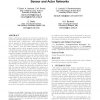107 search results - page 21 / 22 » An Efficient Coordination Architecture for Autonomous Robot ... |
IROS
2006
IEEE
13 years 11 months ago
2006
IEEE
This work is about the relevance of Gibson’s concept of affordances [1] for visual perception in interactive and autonomous robotic systems. In extension to existing functional ...
ATAL
2010
Springer
13 years 6 months ago
2010
Springer
The coordination of emergency responders and robots to undertake a number of tasks in disaster scenarios is a grand challenge for multi-agent systems. Central to this endeavour is...
MOBIHOC
2008
ACM
14 years 4 months ago
2008
ACM
Sensor networks are expected to evolve into long-lived, autonomous networked systems whose main mission is to provide in-situ users ? called actors ? with real-time information in...
IPCV
2007
13 years 6 months ago
2007
- An architecture system and a method for tracking people are presented for sports applications. The system’s input is video data from static camera and the output is the real wo...
JIRS
2000
13 years 5 months ago
2000
Agents (hardware or software) that act autonomously in an environment have to be able to integrate three basic behaviors: planning, execution, and learning. This integration is man...

